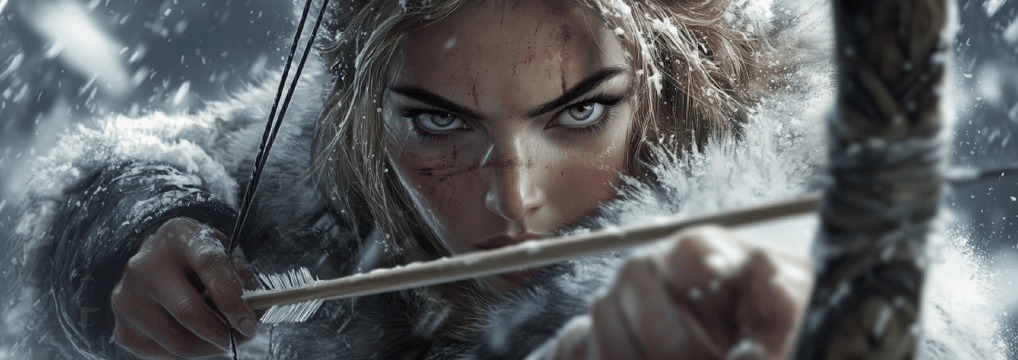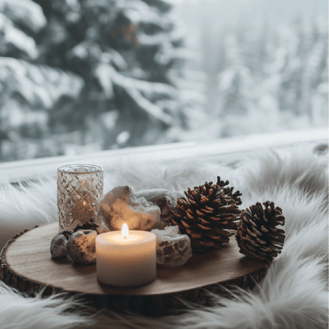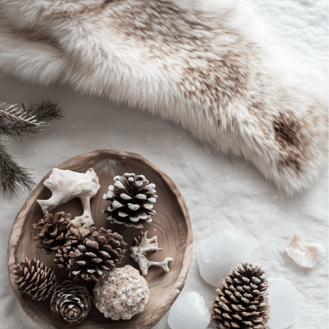Skaði – Norse Goddess of Winter, Skiing, and Survival
Explore the fierce and inspiring legacy of Skaði (Skah-dee), the Norse goddess of winter, skiing, and survival. From her icy mountain home to her role as a protector of those braving harsh climates, Skaði embodies resilience, independence, and harmony with nature. Discover her mythology, symbols, and modern relevance, and learn how to connect with her powerful energy in your daily life.
GODDESSES
Goddess Hive
1/7/20256 min read
Welcome, Goddess Hive! Some links in this blog are affiliate links. Meaning, if you choose to shop through the links on this page, a small percentage of the sale will go to me at no additional cost to you. Thank you for your support. Goddess bless.
Skaði: Norse Goddess of Winter
A Storied Beginning: In the Realm of Ice and Shadow
IImagine the frozen expanse of an ancient Norse winter, where snow-draped mountains pierce the heavens and the biting wind hums an eerie song through jagged pine forests. It is within this stark, unforgiving landscape that Skaði, the Goddess of winter, emerges as a beacon of resilience and mastery over nature's extremes.
She is the fierce and resilient Goddess who embodies the indomitable spirit of survival and mastery over winter’s relentless grip. A cloak of wolf fur draped over her shoulders, skis strapped to her feet, and a bow slung across her back, Skaði moves effortlessly through the snow. This Goddess is a living testament to humanity’s capacity to endure and thrive in the harshest of conditions.
Her legend, born of vengeance and forged in icy solitude, teaches us flexibility, self-reliance, and the importance of finding balance between opposing forces. These timeless lessons inspire those who seek strength and adaptability in life’s most trying seasons, reminding us that growth often comes from embracing challenges and leaning into our inner fortitude.
The Origin and Role of Skaði in Norse Lore
Skaði's story begins with a profound act of vengeance. Daughter of the Jötunn (giant) Þjazi, Skaði descends upon the Aesir Gods to demand restitution for her father’s death. As recompense, she chooses a husband among them and receives a hearty laugh from Loki—a requirement she herself imposes to lighten her heavy heart. This narrative establishes Skaði as a bridge between two worlds: the primal, untamed wilderness of the Jötnar and the structured, divine realm of the Aesir.
Skaði’s practical function in human development is clear: she represents resilience, resourcefulness, and harmony with nature’s extremes. She is the protector of those who dwell in icy terrains, guiding hunters, skiers, and those who dare to conquer the elements. Her influence reminds us that survival requires not just physical endurance but also mental fortitude and an intimate connection with our environment.
Who is Skaði? Followers and Artifacts of Her Presence
Skaði is often revered by individuals who thrive in winter sports, hunting, or mountain living. Her essence calls to those who find solace and strength in solitude, who appreciate the stark beauty of snow-covered landscapes, and who embrace the cold as a crucible of transformation. Skiers, mountaineers, and winter adventurers often pay homage to her, seeing in Skaði a guardian spirit who sharpens their skills and protects them from harm.
Artifacts and symbols associated with Skaði reflect her connection to winter and survival. Ancient carvings depict her wielding a bow, accompanied by wolves or bears, her steadfast companions in the wilderness. Norse sagas mention her affinity for skis and snowshoes, tools that symbolize her mastery over snowbound landscapes. Modern followers may honor her through handcrafted skis, engraved bows, or even winter-themed altars adorned with pinecones, animal furs, and glacial stones.
The Sacred Symbol of Skaði
Skaði’s sacred symbol is often represented by the wolf, a creature that mirrors her independence, cunning, and survival instinct. The wolf’s howl, echoing across the frozen tundra, serves as a spiritual call to those who follow Skaði’s path—a reminder to embrace their inner strength and adaptability.
Additionally, skis and the bow and arrow are potent symbols of her dominion. Skis represent physical agility and the freedom to traverse even the most forbidding landscapes, while the bow and arrow signify her prowess as a huntress and her deep connection to the wilderness.
Did Skaði Have a Consort?
Skaði’s union with Njörðr, the Sea God, stands as a fascinating tale of opposites attracting—and the challenges of reconciling vastly different worlds. Njörðr, a deity of calm seas and coastal tranquility, was chosen by Skaði through an unconventional process: she selected her husband by examining only his feet.
The marriage was fraught with tension, as Skaði longed for her icy mountain home while Njörðr preferred the gentle waves of the shore. Ultimately, their union dissolved, symbolizing the difficulty of harmonizing such divergent domains. Skaði’s choice to part ways with Njörðr highlights her unwavering independence.
She remained a solitary figure, embodying self-reliance and the ability to find fulfillment without the need for constant companionship. This aspect of her story resonates deeply with modern individuals who value autonomy and self-determination.
The Controversies Surrounding Skaði’s Legacy
Like many Goddesses, Skaði’s prominence in Norse mythology has often been overshadowed by her male counterparts. Some scholars argue that her role was diminished as Norse society shifted from matriarchal to patriarchal values. Additionally, Skaði's association with the wild and untamed—qualities often feared or misunderstood—may have contributed to her marginalization in later retellings of the myths.
Despite this, Skaði’s legend endures, a reminder of the strength and resilience that lies within those who embrace their own wilderness. Modern revivals of Norse paganism, such as Asatru, have rekindled interest in Skaði. In this practice, she is celebrated as a vital figure who empowers individuals to navigate life’s storms with courage and grace. Practitioners honor her through winter rituals, creating altars adorned with symbols of her icy realm, and engaging in activities like skiing and cold-weather meditation to connect with her resilient spirit.
The Modern Relevance of Skaði
Skaði’s lessons resonate profoundly in today’s world, where resilience and adaptability are more important than ever. In an era marked by climate change, economic uncertainties, and shifting social landscapes, Skaði’s example reminds us of the importance of cultivating inner strength and resourcefulness. Her connection to nature encourages sustainable living and a deep respect for the environment, while her independence inspires individuals to forge their own paths, even in the face of adversity.
Connecting with Skaði in Daily Life
To connect with Skaði, one can embrace the elements and incorporate winter-themed rituals into daily life. Start by spending time outdoors in cold weather. Enjoy outside activities such as skiing, hiking, or simply walking in the snow. Create a personal altar dedicated to Skaði, featuring items such as pine branches, animal furs, and silver or white candles to evoke the icy glow of her realm. Meditation on the sound of wind or the crunch of snow underfoot can serve as a powerful means of attuning to her energy.
Another way to honor Skaði is to cultivate resilience in your own life. Set goals that challenge your physical and mental limits, and embrace the lessons that come from overcoming obstacles. Remember, Skaði’s guidance is not about avoiding hardship but learning to thrive within it.
Skaði, the Norse goddess of winter, skiing, and survival, stands as a powerful symbol of endurance and independence. Her story invites us to embrace the beauty and challenges of life’s most daunting seasons, reminding us that within the icy embrace of hardship lies the potential for growth and transformation. By honoring Skaði’s legacy, we awaken our own capacity for resilience and discover the strength to carve a path through even the most forbidding landscapes.
FAQs about Skaði
1. What are Skaði’s most notable myths?
Skaði’s demand for compensation from the Aesir and her marriage to Njörðr are among her most well-known stories, illustrating her determination and independence.
2. What animals are associated with Skaði?
Wolves and bears are commonly linked to Skaði, symbolizing her connection to the wild and her survival instincts.
3. How is Skaði honored in modern times?
Followers of Norse paganism honor Skaði through rituals, offerings, and activities such as skiing, hunting, or meditating in winter landscapes.
4. What colors and elements are associated with Skaði?
Skaði is often associated with silver, white, and icy blue, reflecting her dominion over snow and frost. Her elemental connection is primarily to water and air, especially in their frozen forms.
5. Is Skaði considered a protector?
Yes, Skaði is viewed as a protector of those who dwell in or journey through harsh, wintry environments. She offers guidance and strength to those who respect her domain.
6. Can Skaði’s energy help with modern challenges?
Absolutely. Skaði’s teachings of resilience, adaptability, and harmony with nature offer timeless wisdom for navigating life’s difficulties.
Sources for Further Exploration
“The Prose Edda” by Snorri Sturluson
Ellis Davidson, H. R. “Gods and Myths of Northern Europe”
Simek, Rudolf. “Dictionary of Northern Mythology”
Modern Asatru and Norse Paganism websites such as The Troth and Nordic Animism.







About us
The content provided on OMG, including blog posts, rituals, prayers, meditations, and other materials, is intended for informational, educational, and spiritual enrichment purposes only. It is not a substitute for professional medical advice, diagnosis, or treatment. If you have any concerns regarding your physical or mental health, please consult a qualified healthcare profession.
Take care of yourself first, then take care of everyone else. That is the nature of Goddess-ship.
Be well. Goddess Bless.
Empowerment
Empowering femininity through education and self-care.
Goddess
goddesshive@ohmygoddess.com
© 2024. All rights reserved.
